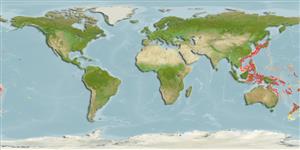Actinopterygii (ray-finned fishes) >
Pleuronectiformes (Flatfishes) >
Citharidae (Citharids) > Citharinae
Etymology: Citharoides: Latin, cithara = lire like instrument + Greek, oides = similar to (Ref. 45335). More on author: Hubbs.
Environment / Climate / Range
Ecology
Marine; demersal; depth range 121 - 271 m (Ref. 11790). Tropical, preferred ?
Western Pacific: Philippines, Japan (Sagami Bay and Kasumi) and the Korean Peninsula.
Size / Weight / Age
Maturity: Lm ? range ? - ? cm
Max length : 29.0 cm TL male/unsexed; (Ref. 9797)
Short description
Morphology | Morphometrics
Rare. Minimum depth at 121 m and feeds on bottom-living animals (Ref. 9797).
Life cycle and mating behavior
Maturity | Reproduction | Spawning | Eggs | Fecundity | Larvae
Hensley, D.A., 2001. Citharidae. Largescale flounders. p. 3794-3798. In K.E. Carpenter and V. Niem (eds.) FAO species identification guide for fishery purposes. The living marine resources of the Western Central Pacific. Vol. 6. Bony fishes part 4 (Labridae to Latimeriidae), estuarine crocodiles. FAO, Rome. (Ref. 9797)
IUCN Red List Status (Ref. 115185)
CITES (Ref. 94142)
Not Evaluated
Threat to humans
Harmless
Human uses
Fisheries: of no interest
More information
Common namesSynonymsMetabolismPredatorsEcotoxicologyReproductionMaturitySpawningFecundityEggsEgg development
Age/SizeGrowthLength-weightLength-lengthLength-frequenciesMorphometricsMorphologyLarvaeLarval dynamicsRecruitmentAbundance
ReferencesAquacultureAquaculture profileStrainsGeneticsAllele frequenciesHeritabilityDiseasesProcessingMass conversion
Tools
Special reports
Download XML
Internet sources
